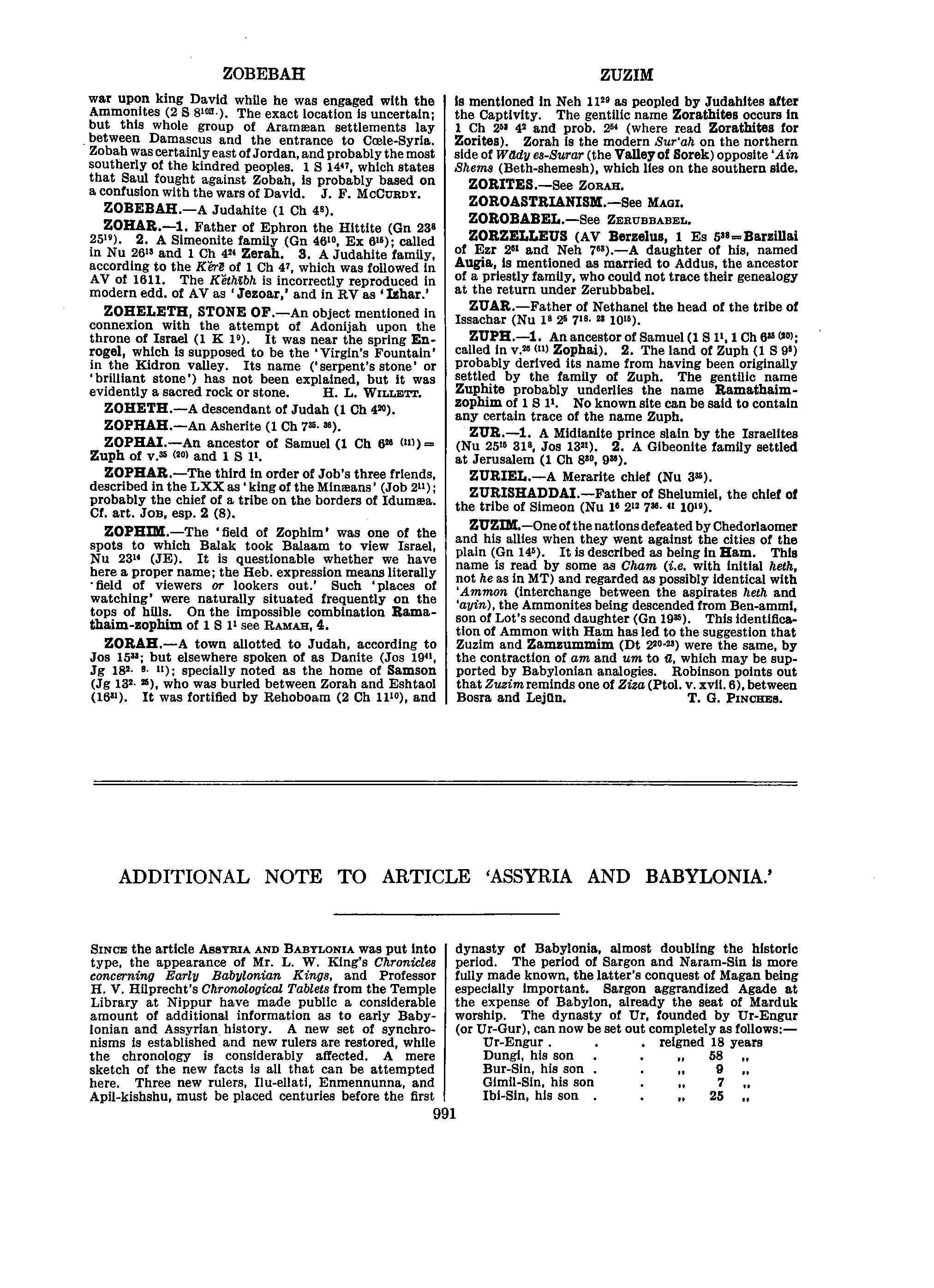
ZOBEBAH
war
upon
king
David
while
he
was
engaged
with
the
Ammonites
(2
S
S'™).
The
exact
location
Is
uncertain;
but
this
whole
group
oJ
Aramaean
settlements
lay
between
Damascus
and
the
entrance
to
Ccele-Syria.
Zobah
was
certainly
east
of
Jordan,
and
probably
the
most
southerly
ol
the
kindred
peoples.
1
S
14",
which
states
that
Saul
fought
against
Zobah,
is
probably
based
on
a
confusion
with
the
wars
of
David.
J.
F.
McCuEDy.
ZOBEBAH.—
A
Judahite
(1
Ch
4').
ZOHAR.—
1.
Father
of
Ephron
the
Hlttite
(Gn
23«
25").
2.
A
Simeonite
family
(Gn
46'»,
Ex
6'«);
called
in
Nu
26"
and
1
Ch
4«
Zerah.
3.
A
Judahite
family,
according
to
the
Keri
of
1
Ch
4',
which
was
followed
in
AV
of
1611.
The
Kethlbh
is
incorrectly
reproduced
In
modern
edd.
of
AV
as
'
Jezoar,'
and
in
RV
as
'
Izhar.'
ZOHELETH,
STONE
OP.—
An
object
mentioned
In
connexion
with
the
attempt
of
Adonijah
upon
the
throne
of
Israel
(1
K
l').
It
was
near
the
spring
En-rogel,
which
is
supposed
to
be
the
'Virgin's
Fountain'
in
the
Kidron
valley.
Its
name
('serpent's
stone'
or
'brilliant
stone')
has
not
been
explained,
but
it
was
evidently
a
sacred
rock
or
stone.
H.
L.
Willett.
ZOHETH.—
A
descendant
of
Judah
(1
Ch
4»).
ZOPHAH.—
An
Asherite
(1
Ch
l'^-
»).
ZOPHAI.—
An
ancestor
of
Samuel
(1
Ch
6«
<'»)
=
Zuph
of
v.»
«o)
and
1
S
1'.
ZOFHAR.—
The
third
in
order
of
Job's
three
friends,
described
in
the
LXX
as
'
king
of
the
Minseans
'
(Job
2")
;
probably
the
chief
of
a
tribe
on
the
borders
of
Idumsea.
Cf.
art.
Job,
esp.
2
(8).
ZOPHIM.-
The
'field
of
Zophlm'
was
one
of
the
spots
to
which
Balak
took
Balaam
to
view
Israel,
Nu
23"
(JE).
It
is
questionable
whether
we
have
here
a
proper
name;
the
Heb.
expression
means
literally
•field
of
viewers
or
lookers
out.'
Such
'places
of
watching'
were
naturally
situated
frequently
on
the
tops
of
hills.
On
the
impossible
combination
Rama-thaim-zophim
of
1
S
l*
see
Bamah,
4.
ZORAH.
—
A
town
allotted
to
Judah,
according
to
Jos
15";
but
elsewhere
spoken
of
as
Danite
(Jos
19",
Jg
18'-
'■
X);
specially
noted
as
the
home
of
Samson
(Jg
13'-
"*),
who
was
burled
between
Zorah
and
Eshtaol
(16").
It
was
fortified
by
Rehoboam
(2
Ch
ll'»),
and
ZUZIM
Is
mentioned
In
Neh
11">
as
peopled
by
Judahltes
after
the
Captivity.
The
gentilic
name
Zoratiiites
occurs
In
1
Ch
2"
42
and
prob.
2"
(where
read
Zorathites
for
Zorites).
Zorah
is
the
modern
Sur'ah
on
the
northern
side
of
Wady
es-Surar
(the
Valley
of
Sorek)
opposite
'Ain
SheTna
(Beth-shemesh),
which
lies
on
the
southern
side.
ZORITES.—
See
Zobah.
ZOROASTRIANISU.—
See
Maqi.
ZOROBABEL.—
See
Zercbbabel.
ZORZELLEUS
(AV
Berzelus,
1
Es
so^Barzillai
of
Ezr
2"
and
Neh
7").
—
A
daughter
of
his,
named
Aiigia,
is
mentioned
as
married
to
Addus,
the
ancestor
of
a
priestly
family,
who
could
not
trace
their
genealogy
at
the
return
under
Zerubbabel.
ZUAR.-
Father
of
Nethanel
the
head
of
the
tribe
of
Issachar
(Nu
1«
2'
7"'
»
10«).
ZUPH.—
1.
An
ancestor
of
Samuel
(1
S
1'.
1
Ch
6«
»»);
called
in
v."
»>)
Zophai).
2.
The
land
of
Zuph
(1
S
9')
probably
derived
its
name
from
having
been
originally
settled
by
the
family
of
Zuph.
The
gentilic
name
Zuphite
probably
underlies
the
name
Ramathalm-zophim
of
1
S
1<.
No
known
site
can
be
said
to
contain
any
certain
trace
of
the
name
Zuph.
ZUR.
—
1.
A
MIdianite
prince
slain
by
the
Israelites
(Nu
25«
31»,
Jos
13»).
2.
A
Glbeonlte
family
settled
at
Jerusalem
(1
Ch
8",
9»).
ZURIEL.—
A
Merarlte
chief
(Nu
3»).
ZURISHADDAI.—
Father
of
Shelumiel,
the
chief
of
the
tribe
of
Simeon
(Nu
1«
2«
7»-
«
10").
ZUZm,—
One
of
the
nations
defeated
by
Chedorlaomer
and
his
allies
when
they
went
against
the
cities
of
the
plain
(Gn
14').
It
Is
described
as
being
In
Ham.
This
name
is
read
by
some
as
Cham
(i.e.
with
initial
heth,
not
he
as
in
MT)
and
regarded
as
possibly
identical
with
'Amman
(interchange
between
the
aspirates
heth
and
'ayin),
the
Ammonites
being
descended
from
Ben-amml,
son
of
Lot's
second
daughter
(Gn
19").
This
Identifica-tion
of
Ammon
with
Ham
has
led
to
the
suggestion
that
Zuzim
and
Zamzummim
(Dt
22o-2>)
were
the
same,
by
the
contraction
of
am
and
um
to
fl,
which
may
be
sup-ported
by
Babylonian
analogies.
Robinson
points
out
that
Zuzim
reminds
one
of
Ziza
(Ptol.
v.
xvli.
6),
between
Bosra
and
LejQn.
T.
G.
Finches.
ADDITIONAL
NOTE
TO
ARTICLE
'ASSYRIA
AND
BABYLONIA.'
Since
the
article
Assthia
and
Babylonia
was
put
Into
type,
the
appearance
of
Mr.
L.
W.
King's
Chronicles
concerning
Early
Babylonian
Kings,
and
Professor
H.
V.
Hilprecht's
Chronological
Tablets
from
the
Temple
Library
at
Nippur
have
made
public
a
considerable
amount
of
additional
information
as
to
early
Baby-lonian
and
Assyrian
history.
A
new
set
of
synchro-nisms
is
established
and
new
rulers
are
restored,
while
the
chronology
Is
considerably
affected.
A
mere
sketch
of
the
new
facts
is
all
that
can
be
attempted
here.
Three
new
rulers,
liu-ellati,
Enmennunna,
and
Apil-kishshu,
must
be
placed
centuries
before
the
first
dynasty
of
Babylonia,
almost
doubling
the
historic
period.
The
period
of
Sargon
and
Naram-Sin
Is
more
fully
made
known,
the
latter's
conquest
of
Magan
being
especially
Important.
Sargon
aggrandized
Agade
at
the
expense
of
Babylon,
already
the
seat
of
Marduk
worship.
The
dynasty
of
Ur,
founded
by
Ur-Engur
(or
Ur-Gur),
can
now
be
set
out
completely
as
follows:
—
Ur-Engur
.
.
.
reigned
18
years
DungI,
his
son
.
.
,,
58
,,
Bur-Sin,
his
son
.
.
,,
9
,,
Gimil-Sin,
his
son
.
,,
7
,,
Ibl-SIn,
his
son
.
.
„
25
„

